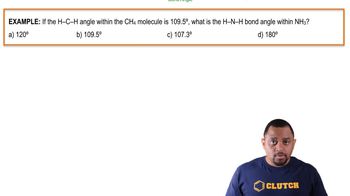A molecule with the formula AB3 has a trigonal planar geometry. How many electron groups are on the central atom?
Ch.11 - Chemical Bonding II: Molecular Shapes, VSEPR & MO Theory

All textbooks Tro 5th Edition
Tro 5th Edition Ch.11 - Chemical Bonding II: Molecular Shapes, VSEPR & MO Theory
Ch.11 - Chemical Bonding II: Molecular Shapes, VSEPR & MO Theory Problem 36
Problem 36
 Tro 5th Edition
Tro 5th Edition Ch.11 - Chemical Bonding II: Molecular Shapes, VSEPR & MO Theory
Ch.11 - Chemical Bonding II: Molecular Shapes, VSEPR & MO Theory Problem 36
Problem 36Chapter 11, Problem 36
Determine the electron geometry, molecular geometry, and idealized bond angles for each molecule. In which cases do you expect deviations from the idealized bond angle? a. CF4 b. NF3 c. OF2 d. H2S
 Verified step by step guidance
Verified step by step guidance1
Determine the electron geometry for each molecule using VSEPR theory.
Determine the molecular geometry for each molecule based on the electron geometry and the number of lone pairs.
Identify the idealized bond angles for each molecular geometry.
Consider the presence of lone pairs and their effect on bond angles to identify any deviations from the idealized bond angles.
Summarize the electron geometry, molecular geometry, idealized bond angles, and any expected deviations for each molecule.

Verified video answer for a similar problem:
This video solution was recommended by our tutors as helpful for the problem above.
Video duration:
2mWas this helpful?
Key Concepts
Here are the essential concepts you must grasp in order to answer the question correctly.
Electron Geometry
Electron geometry refers to the spatial arrangement of all electron groups (bonding and lone pairs) around a central atom. It is determined using the VSEPR (Valence Shell Electron Pair Repulsion) theory, which states that electron groups will arrange themselves to minimize repulsion. Common geometries include linear, trigonal planar, tetrahedral, and octahedral, each associated with specific numbers of electron groups.
Recommended video:
Guided course

Electron Geometry
Molecular Geometry
Molecular geometry describes the three-dimensional arrangement of atoms in a molecule, considering only the positions of the nuclei of the atoms. While electron geometry includes lone pairs, molecular geometry focuses on the shape formed by the atoms themselves. For example, a molecule may have a tetrahedral electron geometry but a trigonal pyramidal molecular geometry if it has one lone pair.
Recommended video:
Guided course

Molecular Geometry with Two Electron Groups
Idealized Bond Angles and Deviations
Idealized bond angles are the angles between adjacent bonds in a molecule, predicted by the electron geometry. For instance, in a tetrahedral arrangement, the ideal bond angle is 109.5 degrees. Deviations from these angles can occur due to factors such as lone pair repulsion, differences in electronegativity, or steric hindrance, which can alter the spatial arrangement of atoms and affect bond angles.
Recommended video:
Guided course

Ideal Bond Angle Example
Related Practice
Textbook Question
2
views
Textbook Question
For each molecular geometry, list the number of total electron groups, the number of bonding groups, and the number of lone pairs on the central atom. (c)
1
views
Textbook Question
Determine the electron geometry, molecular geometry, and idealized bond angles for each molecule. In which cases do you expect deviations from the idealized bond angle? a. PF3 b. SBr2 c. CHCl3 d. CS2
Textbook Question
Which species has the smaller bond angle, H3O+ or H2O? Explain.
Textbook Question
Which species has the smaller bond angle, ClO4- or ClO3- ? Explain.
Textbook Question
Determine the molecular geometry and sketch each molecule or ion using the bond conventions shown in 'Representing Molecular Geometries on Paper' in Section 10.4. c. IF2-